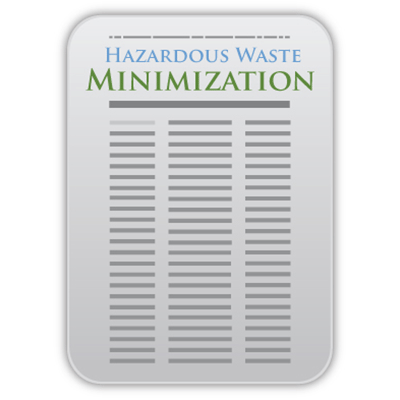
According to the EPA, “the National Waste Minimization Program supports efforts that promote a more sustainable society, reduce the amounts of waste generated, and lower the toxicity and persistence of wastes that are generated.” The program focuses on 31 separate “priority chemicals” found in many of our nation’s wastes and products. The primary focus is on eliminating or reducing the quantity of these chemicals that are produced with a secondary focus on recycling them when reduction or elimination cannot be achieved.
There are a few different tools and methods that can be used to aid in the reduction and elimination of these wastes including, “lean manufacturing, energy recovery, Environmental Management Systems (EMS), and green chemistry.” More information about each of these methods can be found on the Heritage website.
A major player in the minimization game is the hazardous waste reduction plan. A hazardous waste reduction plan (often referred to as a waste minimization plan) is required for all hazardous waste generators. General requirements include:
- Corporate policy statement of support for pollution prevention
- Description of your pollution prevention planning team(s) makeup, authority, and responsibility
- Description of how all of the groups (production, laboratory, maintenance, shipping, marketing, engineering, and others) will work together to reduce waste production and energy consumption
- Plan for publicizing and gaining company-wide support for the pollution prevention program
- Plan for communicating the successes and failures of pollution prevention programs within your company
- Description of the processes that produce, use, or release hazardous or toxic materials, including clear definition of the amounts and types of substances, materials, and products under consideration
- List of treatment, disposal, and recycling facilities and transporters currently used
- Preliminary review of the cost of pollution control and waste disposal
- Description of current and past pollution prevention activities at your facility
- Evaluation of the effectiveness of past and ongoing pollution prevention activities
- Criteria for prioritizing candidate facilities, processes, and streams for pollution prevention projects
These Hazardous Waste Reduction Plans should be updated annually and there should always be a copy onsite. Additionally, while the points above cover national requirements, many states have additional criteria that must be met. By making sure to keep this plan up-to-date and available you can help prevent EPA violations for your company.
More News From Heritage
-
2/21/25
Heritage Announces East Liverpool, Ohio 2025 Environmental Grant Program
Learn about our East Liverpool Ohio grant opportunity!
-
2/18/25
Heritage Environmental Services Announces James (Shelby) Marlow as Chief Financial Officer
Heritage Environmental Services announced today that James (Shelby) Marlow will join the organization as Chief Financial Officer.
-
1/31/25
January Community Engagement Initiative: Home/Work Energy Reduction
Learn about our January community engagement initiative
-
1/29/25
Heritage Environmental Services Announces Chris Ebeling as Chief Commercial Officer
Heritage Environmental Services announced today that Chris Ebeling will join the organization as Chief Commercial Officer.
-
1/28/25
Heritage Environmental Services Addresses Industry Challenges with New State-of-the-Art Shredder
Heritage Environmental Services announced a new state-of-the-art shredding unit.
-
1/7/25
Navigating e-Manifest: What You Need to Know About Hazardous Waste Compliance
Learn about the e-Manifest Third Rule changes that begin January 22, 2025
-
12/23/24
Wreaths Across America 2024
This year, through collective effort and heartfelt generosity, we sponsored 727 wreaths and transported two truckloads of wreaths across the country.
-
12/2/24
Heritage Environmental Services Announces Rachel Evans as Chief Human Resources Officer
Heritage Environmental Services announced today that Rachel Evans will join the organization as Chief Human Resources Officer.








